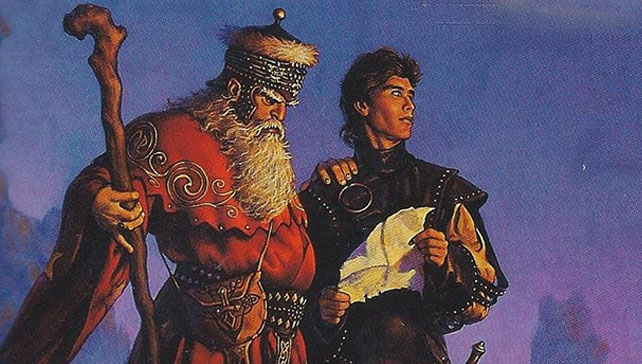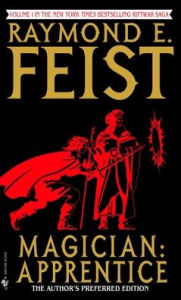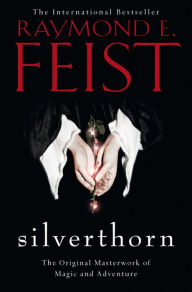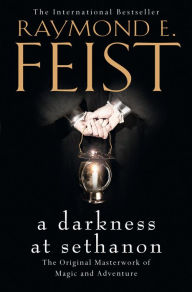Throwback Thursday: Raymond E. Feist, Dungeonmaster of the 1980s
 In the world of fantasy, the shadow of Tolkien’s influence looms large, and readers often fall into one of two camps when discussing his legacy: either every quasi-European secondary world fantasy that came after The Lord of the Rings is an unashamed knockoff, or a spiritual descendant of the best books ever written. Not mentioned nearly as often, and undeservedly so, is the influence that role-playing games like Dungeons and Dragons have had on the genre—an impact nearly as seismic as Tolkien’s. The issue is muddied by the fact that aspects of D&D are lifted more or less wholesale from Tolkien, meaning it’s often difficult to definitively pinpoint where an author may have found inspiration.
In the world of fantasy, the shadow of Tolkien’s influence looms large, and readers often fall into one of two camps when discussing his legacy: either every quasi-European secondary world fantasy that came after The Lord of the Rings is an unashamed knockoff, or a spiritual descendant of the best books ever written. Not mentioned nearly as often, and undeservedly so, is the influence that role-playing games like Dungeons and Dragons have had on the genre—an impact nearly as seismic as Tolkien’s. The issue is muddied by the fact that aspects of D&D are lifted more or less wholesale from Tolkien, meaning it’s often difficult to definitively pinpoint where an author may have found inspiration.
Magician: Apprentice (Riftwar Series #1)
Magician: Apprentice (Riftwar Series #1)
By
Raymond E. Feist
Foreword by
Raymond E. Feist
Paperback $7.99
One exception: Raymond E. Feist’s early 1980s Riftwar series, beginning with Magician (split into two separate novels for U.S. release), and continuing with Silverthorn and A Darkness at Sethanon. These books—and the many, many companion volumes that followed—owe a great deal to Tolkien, true, but they’re also remarkable in that the universe they are set in originated in Feist’s college days, during late-night role-playing marathons with his friends. The worlds of Midkemia and Kelewan are, thus, fully-fleshed out and populated with strange creatures, arcane rules of magic, and rare artifacts befitting hours of devoted care by a group of students looking to avoid studying—providing Feist with tons of narrative bricks to build into novels.
And what really makes this series interesting, even today, is their genius twist: the setting, Midkemia, is an almost-boring Tolkien rehash—until it’s invaded by the much more interesting, original Tsurani, who have stolen across the border from the of Kelewan.
One exception: Raymond E. Feist’s early 1980s Riftwar series, beginning with Magician (split into two separate novels for U.S. release), and continuing with Silverthorn and A Darkness at Sethanon. These books—and the many, many companion volumes that followed—owe a great deal to Tolkien, true, but they’re also remarkable in that the universe they are set in originated in Feist’s college days, during late-night role-playing marathons with his friends. The worlds of Midkemia and Kelewan are, thus, fully-fleshed out and populated with strange creatures, arcane rules of magic, and rare artifacts befitting hours of devoted care by a group of students looking to avoid studying—providing Feist with tons of narrative bricks to build into novels.
And what really makes this series interesting, even today, is their genius twist: the setting, Midkemia, is an almost-boring Tolkien rehash—until it’s invaded by the much more interesting, original Tsurani, who have stolen across the border from the of Kelewan.
Silverthorn (Magician: Apprentice Series #2)
Silverthorn (Magician: Apprentice Series #2)
In Stock Online
Paperback $7.99
A literal Invasion of Ideas
It’s possible to view the original Riftwar books as an extended metaphor about fantasy novels. Midkemia is fundamentally Middle Earth with a facelift: it’s Earth-like in climate, it’s populated by humans locked in a medieval-level of technology and social structure, there are elves and dwarves (naturally). It even borrows some of the language and terminology from Tolkien’s works. This isn’t bad world-building—Midkemia is incredibly detailed and consistent, populated by engaging, interesting characters. But it’s clearly a riff on the standard fantasy-universe formula.
Which brings us to the reason these books are so much fun: very quickly, Feist introduces the “rift” part of the Riftwar, a connection between Midkemia and the world of Kelewan that allows invading forces from the alien world to enter and lay waste to the landscape. Eventually, the protagonist, a humble kitchen boy named Pug destined to become the most powerful magician in the world (naturally), is captured and taken to Kelewan as a slave—and Kelewan is much more interesting than Midkemia. Feist smartly keeps our exposure to Kelewan to a minimum, maintaining an intriguing mystery that energizes the story, as something alien and unknown invades something comfortable and familiar.
A literal Invasion of Ideas
It’s possible to view the original Riftwar books as an extended metaphor about fantasy novels. Midkemia is fundamentally Middle Earth with a facelift: it’s Earth-like in climate, it’s populated by humans locked in a medieval-level of technology and social structure, there are elves and dwarves (naturally). It even borrows some of the language and terminology from Tolkien’s works. This isn’t bad world-building—Midkemia is incredibly detailed and consistent, populated by engaging, interesting characters. But it’s clearly a riff on the standard fantasy-universe formula.
Which brings us to the reason these books are so much fun: very quickly, Feist introduces the “rift” part of the Riftwar, a connection between Midkemia and the world of Kelewan that allows invading forces from the alien world to enter and lay waste to the landscape. Eventually, the protagonist, a humble kitchen boy named Pug destined to become the most powerful magician in the world (naturally), is captured and taken to Kelewan as a slave—and Kelewan is much more interesting than Midkemia. Feist smartly keeps our exposure to Kelewan to a minimum, maintaining an intriguing mystery that energizes the story, as something alien and unknown invades something comfortable and familiar.
A Darkness at Sethanon (Magician: Apprentice Series #3)
A Darkness at Sethanon (Magician: Apprentice Series #3)
Paperback $7.99
The Fundamentals
None of that would matter if Feist hadn’t written a great story and created compelling characters to go with it, but luckily, he did, and he has. The series is packed with court intrigue, memorable fights, incredible set pieces involving magic and creatures, and characters who evolve and change (or, in RPG parlance, level-up) as the story progresses. Feist’s skill in putting his characters in situations that subtly call back to earlier events and demonstrate how they have evolved and matured over time is a great display of economical storytelling.
Feist continues to publish books in the Riftwar universe, so it’s not like this series has been forgotten—better to say that these days, they’re taken for granted, or unfairly regarded as standard-issue dragon and sword fantasies. They may start that way, yes, but Feist continues to find refreshing ways of twisting them into new shapes and subverting expectations. The Riftwar Saga remains one of the most fun fantasy series of the 1980s—one well worth exploring some three decades later.
The Fundamentals
None of that would matter if Feist hadn’t written a great story and created compelling characters to go with it, but luckily, he did, and he has. The series is packed with court intrigue, memorable fights, incredible set pieces involving magic and creatures, and characters who evolve and change (or, in RPG parlance, level-up) as the story progresses. Feist’s skill in putting his characters in situations that subtly call back to earlier events and demonstrate how they have evolved and matured over time is a great display of economical storytelling.
Feist continues to publish books in the Riftwar universe, so it’s not like this series has been forgotten—better to say that these days, they’re taken for granted, or unfairly regarded as standard-issue dragon and sword fantasies. They may start that way, yes, but Feist continues to find refreshing ways of twisting them into new shapes and subverting expectations. The Riftwar Saga remains one of the most fun fantasy series of the 1980s—one well worth exploring some three decades later.


